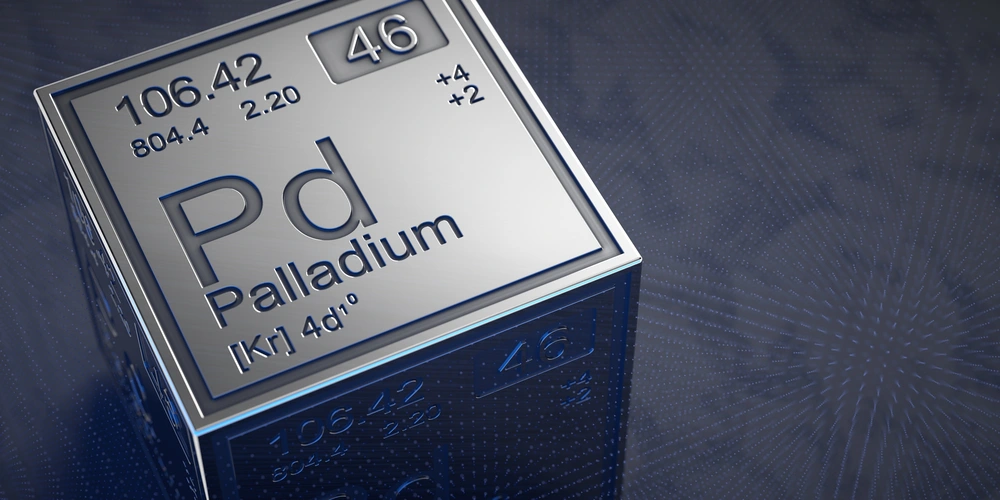
For nearly 30 years, scientists studying light-driven palladium-catalyzed reactions have suspected that a fleeting species of palladium plays a key role in the process.

Leveraging their expertise with special ligands that stabilize intermediates so they can be seen and characterized, University of Illinois Urbana-Champaign researchers led by chemistry professor Liviu Mirica have successfully stabilized and characterized the elusive Pd(I) halide complex and confirmed its key role in light-induced palladium-catalysis.
Initially proposed in the early 1990s, Pd(I) halides have long been theorized to be key intermediates in photochemical catalytic cycles, but their fleeting nature during the reaction has made direct observation and study difficult. This new study published in the Journal of the American Chemical Society provides the first structural and spectroscopic evidence of this intermediate compound.
According to the researchers, these findings provide definitive experimental evidence for the role of Pd(I) compounds as critical intermediates in photochemical palladium chemistry nearly 30 years after the original proposal by Akira Suzuki and Norio Miyaura.
Traditionally, Pd chemistry has been dominated by its 0 and +2 oxidation states. These are key to a class of reactions called cross-coupling reactions, which facilitate the synthesis of compounds of interest to the pharmaceutical and agrochemical industries. By isolating and characterizing the Pd(I) halides, the researchers can now explore elementary organometallic steps at a poorly understood oxidation state of palladium, potentially unlocking a new class of catalytic transformations.
Mirica said now that they know what makes that intermediate species stable, they also know how to dial down the stability so there is more reactivity.
“We can also employ our ligand system in catalytic transformations, but now it can be done in a more logical way, because we know how to control the stability versus the reactivity of these intermediate species,” Mirica said. “This allows us to rationally design catalytic systems for a wider range of photomediated transformations.”
In the last decade, there has been a rapid expansion in the use of light-activated palladium catalysis for organic transformations, opening the door to new reactivities and reaction paths that are not accessible through traditional palladium catalysis, which is driven by heat rather than light.
In a literature review of previous studies in this burgeoning area of chemistry, graduate students Sagnik Chakrabarti and Siddhartha Banerjee identified a phosphorus-based ligand that may hinder the catalytic cycle and give them a shot at isolating this intermediate and study its reactivity.

Chakrabarti, now a postdoctoral researcher at Northwestern University, said their team had been aware of the previous studies because of the group’s interest in understanding the chemistry of unusual oxidation states of palladium.
“And we were always thinking how we could contribute to this area,” he said. “It's a very logical jump to go from something that's catalytically active and dial down its reactivity. One way to do this is to make use of steric hindrance that shields the reactive center, in this case the palladium atom. Once we identified the correct ligand, which shields the palladium to a larger extent than the ligands that are used in catalysis, everything kind of fell into place. This is an old trick in the organometallic playbook where you sacrifice reactivity to stabilize and observe a fleeting chemical species.”
Anyone who wants to study these systems, Chakrabarti said, now has a starting point for what these compounds “look like” in solution, and they can build up from this starting point by performing detailed reactivity studies.
“We have been able to isolate these compounds, and now we have their spectroscopic signatures as well, which will help people who want to understand reaction mechanisms pertaining to palladium photocatalysis in the future,” Banerjee said.
Importantly, the research shows that the lifetime and reactivity of these Pd(I) species can be tuned by modifying the phosphine ligands employed, laying the groundwork for future catalyst design. This could enable new strategies for cross-coupling reactions with substrates that are inert under traditional ground-state Pd catalysis.
Specifically, Chakrabarti said there are opportunities in medicinal chemistry where there is a push to make non-planar molecules by introducing aliphatic groups containing tetrahedral carbon atoms. Non-planar molecules can be more effective drugs, he explained.
“And palladium-catalyzed cross-coupling, even though it's a very mature and very reliable technology, had not classically been able to deal with these C(sp3)-rich molecules well. Light allows palladium to engage these unsaturated substrates in useful reactions,” Chakrabarti explained. “Through this work, we have validated the proposed intermediates, and now we can dial down or dial up the reactivity of these systems to target building these non-planar molecules in other reactions. So that's kind of the catalytic perspective of using palladium in new transformations that usually have not employed such metal catalysts.”
Banerjee, a third-year graduate student at Illinois, said he thoroughly enjoyed this research project, because of its broad scope and variety.
“There was complex inorganic synthesis, followed by extensive characterization, photochemical experiments and theoretical calculations,” Banerjee said. “It was a well-rounded experience that helped me develop a wide range of skills, and I am very grateful for that. I’m super excited to keep building on this work because there’s so much potential - from studying the photophysics of these complexes and doing computational studies to exploring new inorganic and organic transformations.
Editor’s notes:
Contact Prof. Liviu Mirica at mirica@illinois.edu.
"Capturing the Hybrid Palladium(I)-Radical Pair Relevant to Photoexcited Palladium Catalysis": Chakrabarti, S.; Banerjee, S.; Mirica, L. M., J. Am. Chem. Soc., 2025, 147, 41882-41896.
The research paper is available at https://doi.org/10.1021/jacs.5c14709.